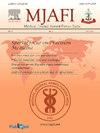三种失弛缓症亚型干预前和干预后食管压力地形测量:一项针对印度成年人的试点研究
Q2 Medicine
引用次数: 0
摘要
背景贲门失弛缓症的特征是吞咽时食管下括约肌(LOS)松弛失败和蠕动异常。本研究旨在观察对三种亚型贲门失弛缓症的干预效果,并比较三种亚型间的干预效果。方法41例患者行贲门失弛缓症严重程度Eckardt评分,随后行高分辨率测压(HRM)。经过3个月和6个月的干预(气动扩张或海勒心肌切开术),重复Eckardt评分和HRM,并与初始结果进行比较。结果41例患者中,ⅰ型失弛缓症13例(31.71%),ⅱ型18例(43.90%),ⅲ型10例(24.39%)。三种亚型中位综合松弛压力(IRP)和Eckardt评分在干预前和干预后均存在显著差异。虽然干预的有益效果在干预后持续了6个月,但它低于干预后3个月的价值。在干预后3个月和6个月,腹腔镜Heller’s mytomy (LHM)和气动扩张(PD)对II型失弛缓症的干预成功率最高。结论一次性干预对三种亚型均有效。这种益处随着时间的推移逐渐减少,但在干预六个月后仍然显著。II型失弛缓症在干预后3个月和6个月表现出最好的干预效果。与其他亚型相比,III型失弛缓症反应最少,对干预反应最差。在III型失弛缓症6个月结束时,一次性干预的益处也恶化最多。本文章由计算机程序翻译,如有差异,请以英文原文为准。
Pre- and post-intervention oesophageal pressure topography metrics in the three subtypes of achalasia: A pilot study on Indian adults
Background
Achalasia is characterized by failure of relaxation of the lower oesophageal sphincter (LOS) and abnormal peristalsis during swallowing. The study aimed to observe the effects of intervention in three sub-types of achalasia and compare the intervention outcomes among the three sub-types.
Methods
Forty-one patients underwent Eckardt scoring for severity of achalasia, followed by high-resolution manometry (HRM). After three and six months of intervention (pneumatic dilatation or 'Heller's Cardiomyotomy), Eckardt scoring and HRM were repeated and compared with the initial results.
Results
Out of the 41 patients, 13 were diagnosed with type I achalasia (31.71%), 18 with type II (43.90%), and 10 with type III (24.39%). Significant differences between the pre- and post-intervention values of median integrated relaxation pressure (IRP) and Eckardt score were found in all three sub-types. Although the beneficial effect of intervention lasted up to six months postintervention, it was less than three months postintervention values. The intervention success rates were highest for both laparoscopic Heller's myotomy (LHM) and pneumatic dilatation (PD) in Type II Achalasia at three and six months postintervention, respectively.
Conclusion
One-time intervention is effective in all three sub-types. This benefit tends to taper over time but remains significant after six months of intervention. Type II Achalasia shows the best intervention outcomes compared to the other two sub-types at three months and six months post-intervention. Type III Achalasia shows the least response compared to other sub-types and is the poorest responder to intervention. The benefit of one-time intervention also deteriorates most in type III achalasia at the end of six months.
求助全文
通过发布文献求助,成功后即可免费获取论文全文。
去求助
来源期刊

Medical Journal Armed Forces India
Medicine-Medicine (all)
CiteScore
3.40
自引率
0.00%
发文量
206
期刊介绍:
This journal was conceived in 1945 as the Journal of Indian Army Medical Corps. Col DR Thapar was the first Editor who published it on behalf of Lt. Gen Gordon Wilson, the then Director of Medical Services in India. Over the years the journal has achieved various milestones. Presently it is published in Vancouver style, printed on offset, and has a distribution exceeding 5000 per issue. It is published in January, April, July and October each year.
 求助内容:
求助内容: 应助结果提醒方式:
应助结果提醒方式:


